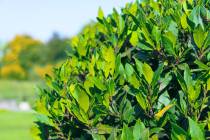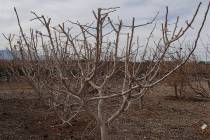Girdling keeps plant roots from spreading properly
Q: We notice that some of our trees don’t seem to be rooting into the soil properly. We assume it’s because of improper root ball preparation or girdling roots. Our test to see if the tree has rooted after at least one growing season is to bend the tree trunk back and forth. If the root ball under the soil easily moves when the tree is pushed, we assume that the tree has poor or little rooting into the surrounding soil.
We also believe it’s a permanent problem, not correctable and thus the tree needs to be replaced. Any suggestions for making a better evaluation and discovering this potential problem before planting?
A: Poor tree establishment because of girdling or circling roots is a major problem with many plants, not just trees. This problem can begin at an early age, even when it is just a seedling. But if plants are grown too long in containers, then the problem can become worse.
Once roots begin growing in circles inside a container the problem can no longer be corrected, even at planting time. This problem should be identified before purchasing and the plant rejected.
Generally speaking, plants that are large compared to their containers have a significant chance of having girdling roots. Buying oversized trees in containers is no bargain.
When buying a container plant that I can lift, I will gently pull the plant a few inches out of the container and inspect the roots for circling. This includes bedding plants. Second , I select trees that are not oversized for their container. Here is a case where smaller plants in the same sized containers will outperform the larger ones.
Boxed trees are replanted from container s. Normally, container trees are staked as soon as they are planted in a box. However, if the container tree had girdling roots then it will continue to girdle and never establish in the box.
Plants in containers should usually root, or become established, in one full growing season. Large trees, such as those planted from boxes, may take two to three seasons. Malformed, girdling roots will circle in the same pattern once they are planted in the ground. Because of this, they will never grow beyond the planting hole after planting. If they never grow beyond the planting hole, the roots will never be strong enough to support the tree when it gets bigger.
A sign that a tree may have circling or girdling roots after it has been planted is stunted growth. This stunted growth can take years after planting before it appears. It is a good idea to identify trees that have this problem early in their development.
Another indicator is the presence of girdling roots on the soil surface and a lack of trunk flaring at the soil surface, but this can take years to develop.
Your method for determining if trees have not become established after planting is a good one. Once the establishment period is over, I use the same procedure that you prescribe to determine if there are girdling roots .
Other things that can cause poor rooting into the surrounding soil are: poor hole/soil preparation, improper staking or not staking after planting and watering too close to the tree.
Q: We have two holly trees in our front yard that are at least 40 years old. Last summer one of the trees began to get curled leaves and this year the entire tree looks like it is dying. The trees are on the north side of our house and get sun in the morning and afternoon. We were told that the trees are probably dying from old age but they didn’t know the name of the tree. We had our entire front yard replaced with desert landscaping this spring but that should not have caused the problem because one of the trees began getting curled leaves last year.
A: Years ago, Chinese holly (Ilex cornuta) was commonly planted as a foundation plant in Southern Nevada. They performed best on the north or east sides of a home, somewhat protected from the hot sun.
The most commonly planted Ilex was Burfordii or Burford holly. You can search the Internet and see if it matches your plant. With the onset of desert plants and desert landscaping it has been forgotten, along with some other really cool plants. All the nurseries in Las Vegas carried it 40 years ago and many did until about 20 years ago.
Burford holly is fairly long-lived but I have to agree that as they age, without proper care, they will begin to decline.
I am not sure what the problem is but since one or two limbs are dying back you will most likely see the cause by following those dead limbs back inside the plant until the dying stops. The problem should be at that spot or close to it.
A real guess is that it might be a wood boring insect that is common to all plants here. I rather doubt that it is a disease but it is most likely mechanical or physical damage by insects tunneling or accidental damage by a human .
Burford holly is a beautiful plant if it is well cared for. It will get to about 6 feet, or taller in protected areas. It can be grown into a small tree and might get as tall as 20 feet. The thick glossy leaves have spines but they are not nearly as spiny as English holly.
They will produce red berries in winter if you have a female plant and there is a male nearby. Sometimes they appear to produce these red berries with no apparent mate nearby. All hollies grow best in rich, slightly acidic soils. They would do nicely grouped with camellias and other sun-tender and acid-loving plants.
Remove dead limbs by cutting them just above the healthy part of the limbs. Add another drip emitter or increase the amount of water that is applied and apply a fertilizer such as Miracid or a fertilizer for acid-loving plants at least once a year in the spring. Do it now if it has not had any for a while.
Applying mulch to the base of the plants will help conserve moisture, add nutrients to the soil, make the soil more acidic, reduce weed problems and improve the general vigor of the plant. It would help to have it pruned carefully by someone who knows how to prune.
Q: How difficult would it be to propagate Arizona rosewood? And how should I prune it to a multitrunked tree, with more foliage in the 6-to-12-foot height zone?
A: It can be propagated from cuttings and seed. The easiest is from seed.
Cuttings of Arizona rosewood should be taken in May and treated with a rooting hormone. Expect, at best, about 50 percent of the cuttings to root.
With seed, collect seed from seed pods when the pods are fully mature. Put them in a plastic bag and into the freezer for about two months and sow the seeds in sterilized planting mix.
With Arizona rosewood you would want to select four or five main stems coming from the ground or low on the trunk. These should be going in different directions to give the plant balance.
Remove all new or existing small growth from these four to five stems to concentrate growth in the upper canopy. Remove growth going straight up, straight down, too close together or back toward the center.
You will get faster growth if you have fewer stems. Growth will be reduced if you have lots of shoots where growth can occur. Always keep the canopy occupying at least half of the plant’s height for good visual effect.
As the plant gets larger, let the canopy occupy two-thirds of the height of the plant and keep the trunks free of new growth as soon as you see it. If you get it when it is very young, you can usually pull this new growth out and will not need pruning shears.
Q: My friend and I would like to plant a few fruit trees on some property at Acoma Siding in Nevada. It is near Barclay, east of Caliente . I was wondering if you had some advice on types and varieties of fruit trees that may do well there. I believe it is in the 5,000 feet elevation.
A: This advice would also apply to property in Southern Nevada on the way up Mount Charleston and other higher elevations.
Your best bet will be to plant on the side of a hill to avoid late spring freezes. The major limitation for you is minimum temperatures and late spring frosts. To avoid these as much as possible, plant on the sides of hills and avoid low spots where cold air can accumulate .
Without knowing your exact low winter temperatures it would be safe to assume you are in apple, pear, sour cherry and plum country. Perhaps berries such as raspberry and other cane fruit will grow there as well. The best website for general growing information will be Dave Wilson Nursery, www.davewilson.com.
Stay with fruits with a higher chilling requirement, probably around 800 to 900 hours, and check their requirements for pollination. Some apples you can try might be Rome, Delicious, Northern Spy and Harrelson. On apples, have them on a dwarfing rootstock such as M111.
European pears might include Bartlett, Comice and D ’Anjou, but higher chilling hours may be one indicator that they will probably perform better for you.
Because you are in an arid climate with desert soils, mulch the soil and add plenty of soil amendments at the time of planting. That should get you going.
Bob Morris is a horticulture expert living in Las Vegas and professor emeritus for the University of Nevada. Visit his blog at xtremehorticulture.blogspot.com.























